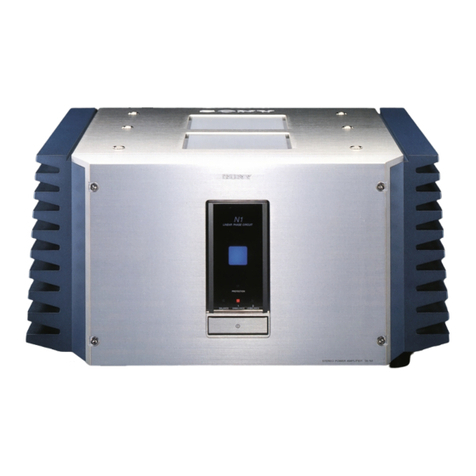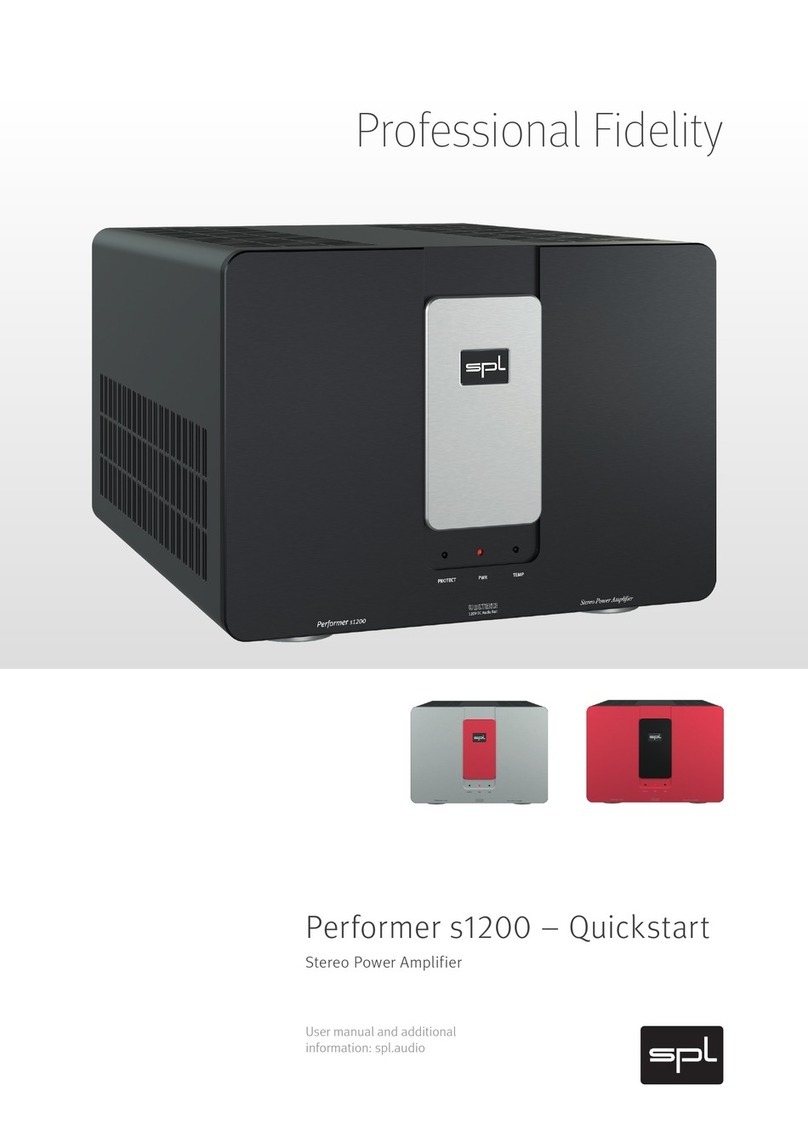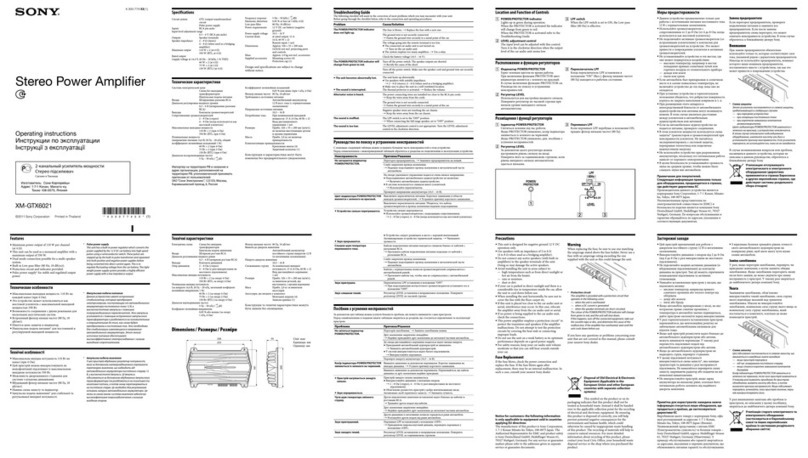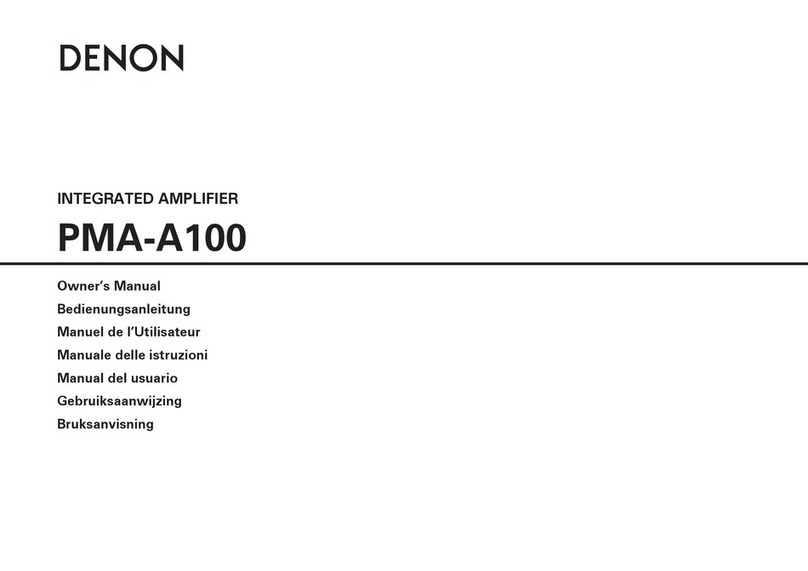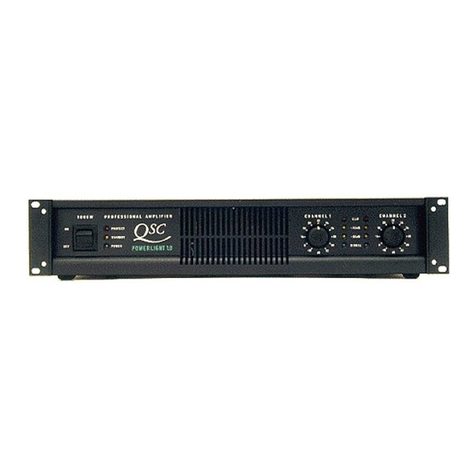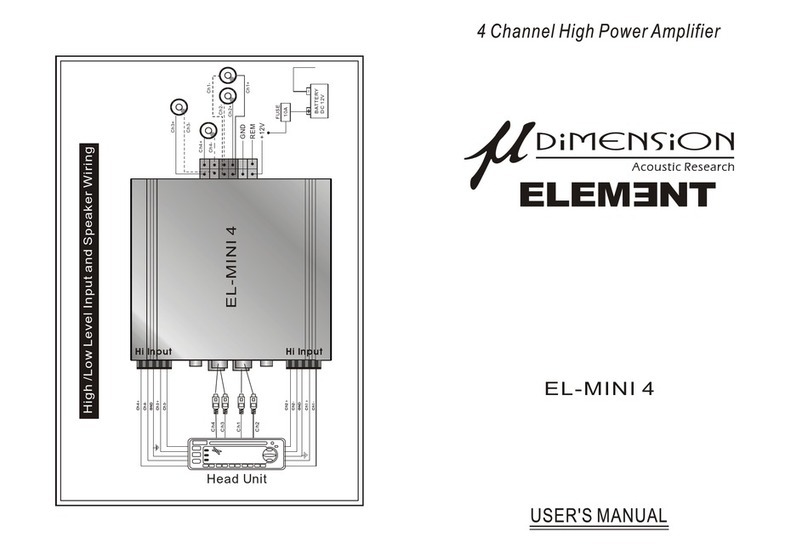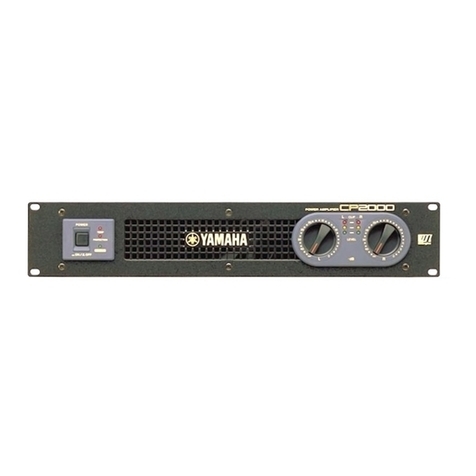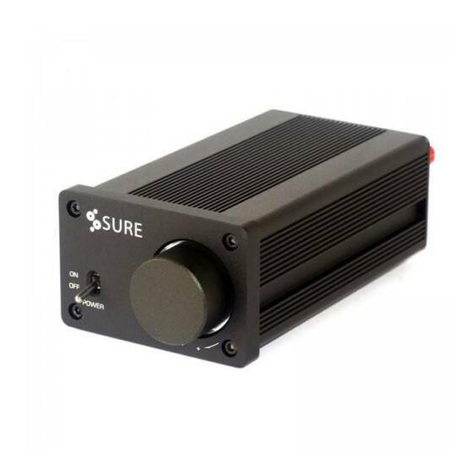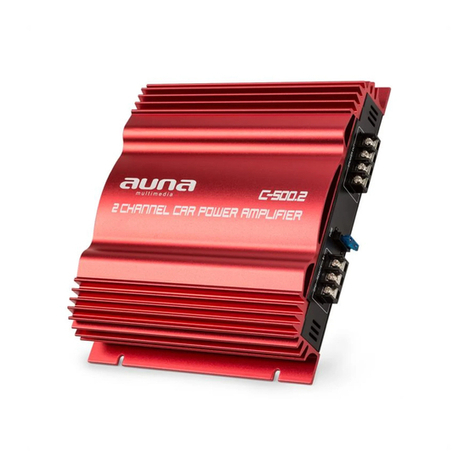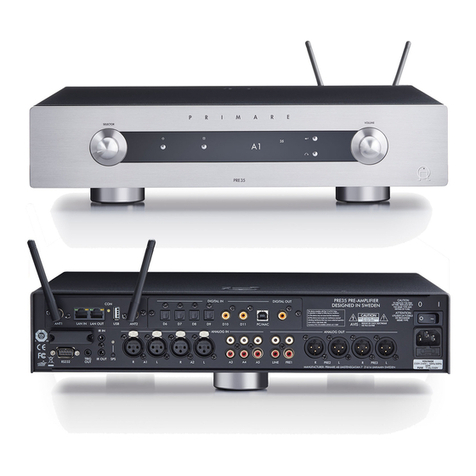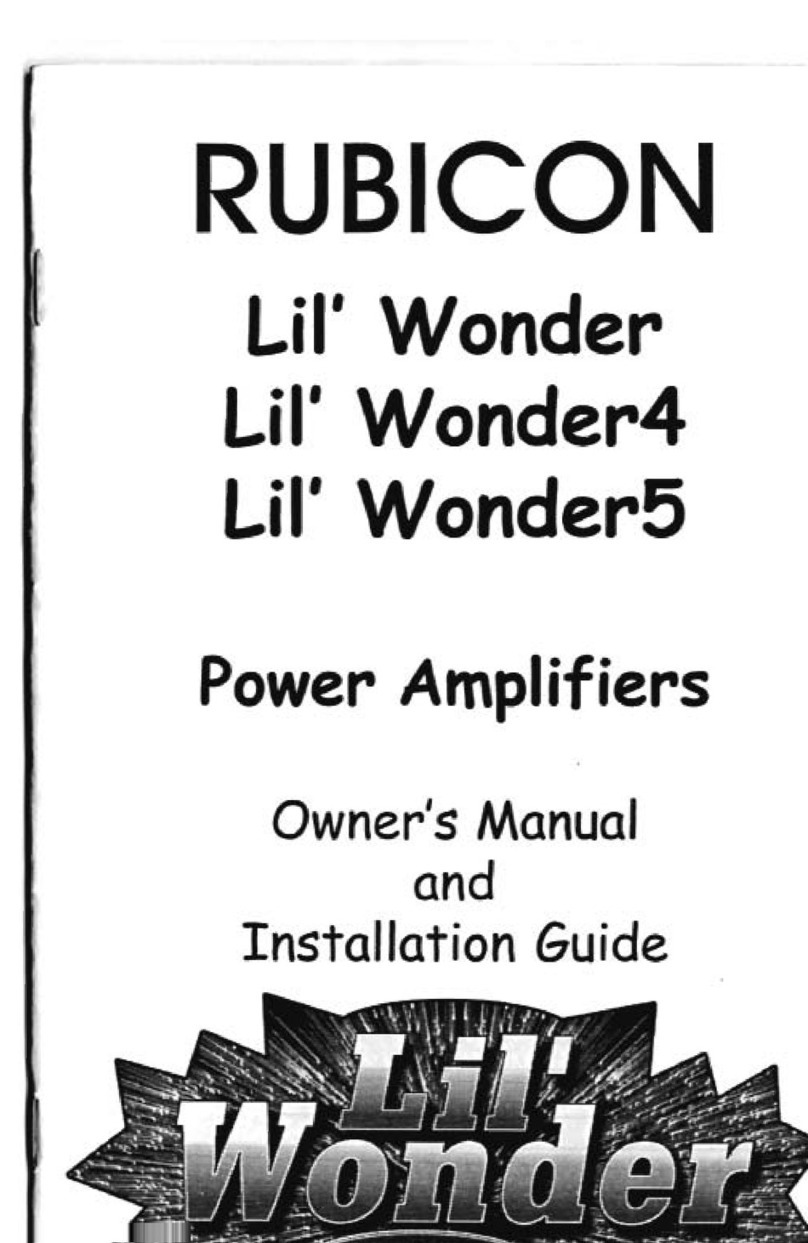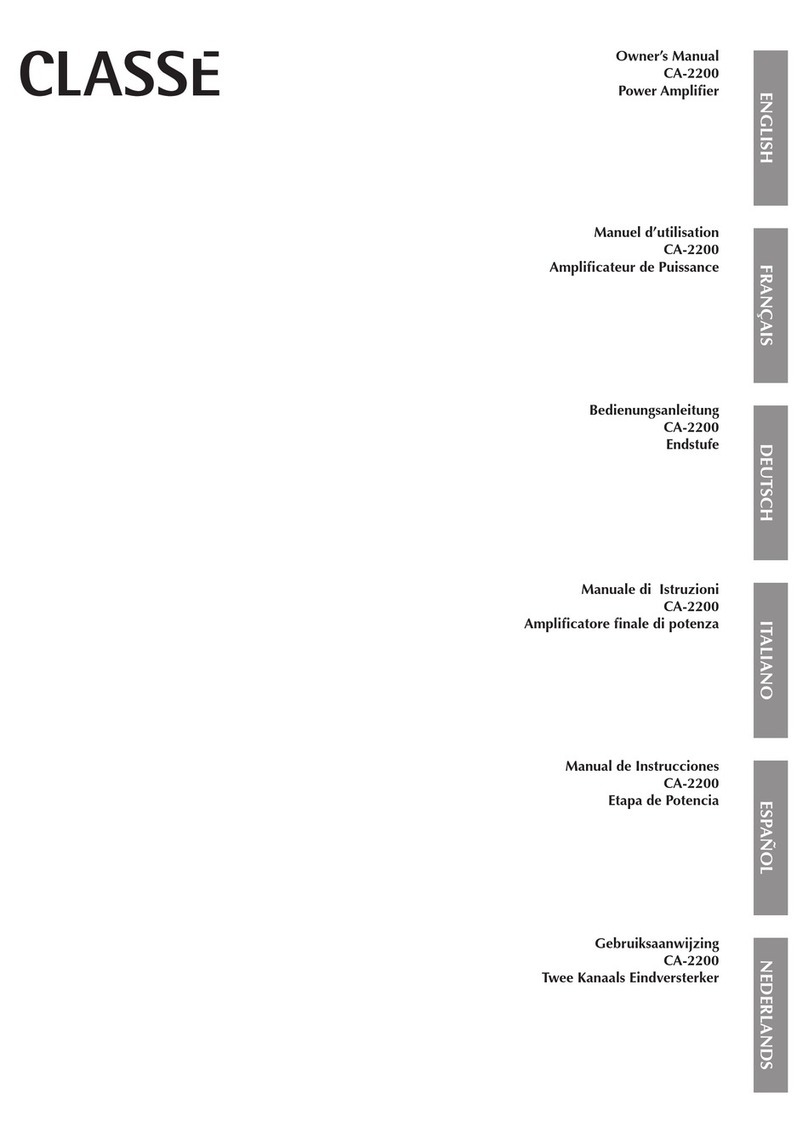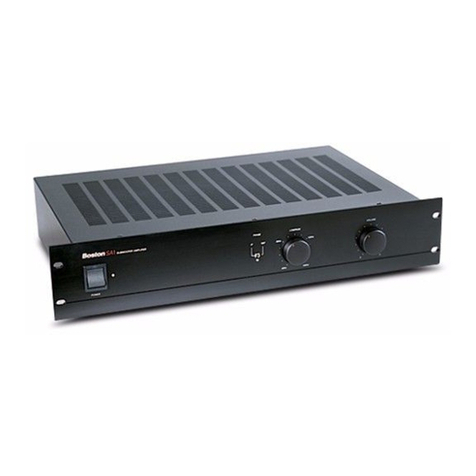THÖRESS Parametric Phono Equalizer Series User manual

THÖRESS
Parametric . Phono Equalizer . Series
=========================
"THE PHONO ENHANCER MK "
............................................................
I N S T R U C T I O N M A N U A L
Thank you for purchasing a phono preamplifier from our Parametric Phono
Equalizer Series.
You have acquired a highly versatile phono preamplifier which allows for on-
the-fly ad ustment of the de-emphasis characteristic, the gain versus frequency
behaviour of the amplifier, within wide limits by means of varying the defining
edge frequencies f1, f2 and f3 by means of three 6-position rotary switches
TCSW1, TCSW2 and TCSW3. These switches act as bass, middletone and treble
controls respectively. The favorable range of the tone selectors have been
determined and optimized by extensive listening tests. The tone selectors are
highly effective tools for restoring tonal imperfections of records (eventually
introduced during the recording or cutting process). Therefor we claim our
preamplifier to be a PHONO ENHANCER.
The amplifier is built with meticulous hand construction using our proven
point-to-point hard wiring techniques, whereas much care has been taken in
arranging each aspect of the internal construction to ensure low noise
performance, ease of service and the highest reliability for many years to come.
Please read the following explanations and instructions carefully to get the
most out of your phono preamplifier.
DE-EMPHASIS AND TONE CONTROL
The gain of a phono pre-amplifier varies with frequency so as to restore the
pre-emphasis introduced to the signal during the record cutting process.
Therefor a phono pre-amplifier is sometimes called PHONO EQUALIZER
(german PHONO ENTZERRER). The de-emphasis characteristic of a phono
equalizer is completely and unambiguosly determined by a set of edge
frequencies (equivalent to so called time constants)
f1 > bass roll-off, f2 > bass turnover, f3 > treble roll-off.

The gain rises below f2 (bass boost) and decreases above f3 (treble
attenuation/roll-off) with a slope approaching 6dB/octave. The difference
between the various pre/de-emphasis prescriptions established by prominent
record companies in the inception of high fidelity audio are rather small, often
negligible, whereas in the most cases the crucial bass-turnover frequency f2
equals 500Hz. A few examples of prominent de-emphasis prescriptions are
given at the end of this manual.
The Phono Enhancer performs highly accurate R AA DE-EMPHAS S when
the tone selectors rest in default position,
(TCSW1, TCSW2, TCSW3) > pos(6, 6, 1) > (f1, f2, f3) = (50, 500, 2124) Hz
This most widely used de-emphasis characteristic is identical with the so called
NEW ORTHOPHONIC prescription established by RCA along with the
microgroove vinyl record standards in the late 1940s, which later on has been
appointed as phono playback standard.
It is important to note that the tonal footprints of individual records (even
between those issued by the same record company in the same period of time)
vary much more widely than the tonal differentiation evoked by even the most
distinctive de-emphasis characteristics. Therefor:
Humble de-emphasis curve selectors are not suitable for restoring optimal
tonal balance of analogue disc records. They are useless, misleading and
puzzling to the user!
The tone control functions of the Phono Enhancer have been
implemented via edge-frequency-shift without involving clumsy and
sound degrading conventional tone control circuitry!
Tonal manipulations via edge-frequency-shift have a much stronger impact in
restoring a satisfactory tonal balance of a given record when ad usted
intuitively by ear
instead of choosing parameters which formally suit the de-emphasis pre-
scription associated with the record company and the vintage of the record.
To determine which selector settings of the Phono Enhancer gives the most
satisfactory tonal balance for a given record, proceed as follows:
STEP 1
Adjust the SON C PRESENCE with TCSW2.
Edge frequency f2 ===> middletone (M TTELTON).
Listen carefully to the record with tone selectors in default position (6, 6, 1).

Turn TCSW2 counter-clockwise to a lower position if a disturbing sharpness in
the sonic presentation is observed. This manipulation increases the bass-
turnover frequency f2 and such gives rise to a smoother (warmer) sonic
presentation. Conversly, turning the middleton switch TCSW2 clockwise
upwards lifts the presence of the sound image, whereas the most vivid
presentattion is associated with position 6 (f2=500Hz, RIAA).
Determining the optimal position of TCSW2 is a crucial part of the sound
enhancing procedure!
STEP 2
Determine the optimal D STANCE AND EXTENT OF THE SOUNDSTAGE by
adjusting TCSW1.
Edge frequency f1 ===> bass (BASS).
Lowering the position of TCSW1 expands the low frequency response of the
amplifier (bass boost below 100 Hz) in a subtle way and such leads to a
presentation with more punch and impact. Moreover, the sound stage will
appear deeper, wider and more distant from the listener.
Weak low end extension of the programm can be compensated by
lowering the position of TCSW1!
The boosting is obtained by attenuating the mid band gain of the amplifier with
respect to the low end of the audio band. Consequently, in order to maintain
the listening volume of the previous sound image, the volume needs to get
adapted on the line device after each movement of TCSW1.
Adapt the listening volume whenever adjustments have been made with
TCSW1 (counter-clockwise movement of TCSW1 > volume(+), clockwise
movement of TCSW1 > volume(-))!
Lowering the position of TCSW1 will also smooth out any sharpness possibly
left in the sound image after step 1 has been taken. This effect is the more
pronounced the lower a position has been previosuly chosen for TCSW2. Thus a
record which is exceptionally thin and sharp sounding with RIAA settings will
sound more appealing when both switches, TCSW2 and TCSW1, are turned to
lower positions. Since records from the early times of HiFi-technonolgy were
often cut at the low end of the audio band, the bass boosting facilities
associated with TCSW1 and TCSW2 are very effective for restoring the original
sound image of an old recording session.
STEP 3
Tune the BR GHTNESS and TREBLE RESOLUT ON with TCSW3.
Edge frequency f3 ===> treble (HÖHEN).

Finally, attention should be given to TCSW3. This switch acts in a similar
manner as the treble knob of a conventional tone control facility, altough its
effect is much more subtle. Turning this knob clockwise upwards to a higher
position lifts f3, thus reduces treble attenuation and such leads to a brighter
sonic presentation. When TCSW3 rests in position 6 the amplifier response is
flat above the bass-turnover frequency f2 (de-emphasis with zero treble
attenuation) which is the adequate setting for playback of 78rpm records
(treble pre-emphasis was not applied with early disc records).
Many early microgroove records sound more appealing when the treble switch
TCSW3 is set to an elevated position in order to brighten-up the sonic
presentation. However, as an unwanted side effect of treble boosting, groove
noise may become more clearly audible. So treble resolution must occasionally
be sacrificed to a certain degree so as to keep the groove noise floor at an
acceptable level (especially when the record in question happens to be in poor
condition). Hints regarding effective record cleaning are given in a dedicated
paragraph of this manual.
Record cleaning should be considered as a crucial activity for all vinyl
lovers who wish to obtain the full benefits from the Phono Enhancer!
STEP 4
Verify the determined selector settings and
RECORD THE OPT MAL CONTROL PATERN FOR LATER REFERENCE.
Record the positions of TCSW1, TCSW2 and TCSW3 established so far as a
temporary result. Then critically check and re-consider the settings by
comparing and re-evaluating the sound images while switching the selectors
one or two steps upwards and downwards from the previous optimum. Once a
final decision upon the optimal selector settings has been made the result
might be written on the record sleeve for later reference.
PHONO CARTRIDGES
Early microgroove records carry a monophonic signal written into a LATERALLY
excited triangular spiral groove of constant depth and were originally meant to
get tracked by a spherical stylus with 25-micron spike radius mounted to a
mono-flexible cantilever. A mono-flexible cantilever is one whith horizontal
compliance only.
By contrast, the groove of a stereophonic record carries two signals (more or
less sharply separated from each other) coded LATERALLY AND VERTICALLY
into the groove by also varying the depth of the groove relative to the record
surface (concomitant with the lateral groove modulation). A stereophonic

cutting head produces a monophonic groove when it is fed with identical
signals on both channels. A groove obtained in this manner is significantly
narrower than a FIRST-GENERATION monophonic microgroove, due to the new
groove standards introduced for stereophony. Therefor a smaler stylus spike
radius of 17 microns was specified for tracking SECOND-GENERATION
microgrooves.
A stereophonic cartridge requires a cantilever which is compliant in all
degrees of freedom (OMN -flexible)!
A phono cartridge with MONO-flexible cantilever will seriously and
irecoverably harm the groove when it is accidentally used for tracking a
stereoponic record!
During the stereophonic era more sophisticated stylus profiles (Shibata, Micro
Ridge, Paratrace, Gyger, van-den-Hull etc.) have been developed from the
simple sperical 17-micron stylus in order to reduce tracking distortion and to
enhance tracking ability of phono cartridges. These modern stylus profiles
provide the further advantage of reduced record and tip wear on account of an
increased contact area (line contact) between the stylus tip and the groove
walls (lower surface preasure).
Phono cartridges featuring a sophisticated stylus profile tend to
significantly outperform cartridges employing a simple spherical profile!
A phono cartridge with omni-flexible cantilever and a spherical 25-
micron stylus can faithfully track (NARROW) second-generation
microgrooves (likely with reduced tracking ability) although this type of
stylus was originally intended for tracking first-generation
microgrooves!
Coversely, every phono cartridge with a spherical 17-micron stylus (or
one of its modern derivatives) can faithfully track (W DE) first-
generation microgrooves although this type of stylus was originally
intended for tracking second-generation microgrooves!
Stereophonic grooves are mono-compatible in a two-fold sense...
Ar first, every stereophonic cartridge is able to read both, early and second-
generation monophonic microgrooves faithfully whereas identical signals will
be developed in the two generator coils. Hereby the omni-flexible stylus is,
theoretically, exposed to lateral excitation only. In practice, vertical movements
of the stylus due to groove imperfections (warp, dirt, scratches) are
converted into signal and such add noise artifacts to the wanted cartridge
output.
SECONDLY, every omni-flexible monophonic cartridge (with a stylus profile

suitable for microgroove reading) is able to faithfully track stereophonic
grooves and to re-combine the fairly well separated R and L signals back into a
consistent mono signal whereby the signal generator of the cartridge converts
only the lateral excitation of the stylus into signal while ignoring vertical
movements.
A sophisticated stereo cartridge is most suitable for faithfully tracking
both early AND second-generation monophonic microgrooves!
A sophisticated stereo cartridge is likely to outperfor a dedicated mono
cartridge with a simple spherical stylus with regard to mono playback,
altough it tends to produce more groove noise than a dedicated mono
cartridge!
The ma ority of currently produced high-grade monophonic MC cartridges are
derivatives of stereo models and as such employ a dual-coil signal generator
(two separate generator coils terminating in 2x2 output terminals) with an
OMNI-FLEXIBLE stylus. The only difference to the corresponding stereophonic
variants is that the generator coils are not arranged at a 45-degree angle to the
tracking plane, as it is needed for stereophonic reading. Examples of omni-
flexible dual-coil mono cartridges are the AUDIO TECHNICA AT33-Mono, the
LYRA mono cartridges and the DYNAVECTOR DV-X1s-Mono. Monoflexible
single-coil MC cartridges of ultimate tracking and sonic capabilities are
currently made by Hyun Lee in Berlin (TEDESKA Pick-up Technology). TEDESKA
mono cartridges feature a sophisticated proprietary stylus profile and a novel
air-coil signal generator principle. Other examples of monoflexible, single-coil
MC cartridges of current production are the mono cartridges produced by
MIYAJIMA LAB in Japan, all of which models (unfortunately) come with simple
spherical stylus profiles.
Use a TEDESKA mono cartridge or a DYNAVECTOR DV-X1s-Mono for
ultimate playback of mono records (with microgoove coding)!
Examples of classic monoflexible single-coil cartridges are the ORTOFON Mono
CG-25 and the EMT OMD-25 These classic pick-up heads (fitted with sperical
25micron styluses) offer an amazingly good sonic presentation even when
udged by today-s standards. However, they cause excessive record and stylus
wear due to their basic diamond profiles and tracking weights in excess of 4
gramms, especially when combined with vintage tonearms without anti-skating
facility. Their use is therefore questionable when maximum sound quality and
preservation of valuable records is the main goal. Nevertheless, they will be an
obvious choice when the aim is to compose a setup for authentic monaural
playback.
LATERAL 78RPM RECORDS

The coding of lateral 78rpm record grooves (often refered to as STANDARD
GROOVES) is similar to the coding applied for microgroove records (laterally
excited triangular spiral grooves of constant depth). However, standard
grooves are considerably wider (and deeper) than early or second-generation
microgrooves and are meant to get tracked by a sperical stylus with 65-micron
spike radius. Notably, stereophonic MM (moving magnet) cartridges of current
production equiped with a 65-micron stylus are readily available and the level
of performace offered by these humble pick-ups is sufficienly high for adequat
78rpm playback.
78 rpm records with standard grooves can be adequately reproduced with a
humble stereophonic MM cartridge (of current production) with a sperical 65-
micron stylus!
Since 78rpm records were cut without treble pre-emphasis and often lack bass
extension, they will likely sound best when equalized with zero treble
attenuation (infinite f3), maximal low frequency extension (f1 as low as
practicable) and regular bass-turnover frequency (f2=500Hz), even when the
formal turnover-frequency specified for equalizing the 78rpm record in
question happens to be lower than 500Hz.
78rpm records with standard grooves are likely to sound best with
selector setting (1, 6, 6).
Nevertheless, lower bass-turnover frequencies than 500Hz can be easily
implemented on some positions of TSCW2 on demand, for those users who
specialize in 78rpm playback and place importance on more finely graduated
bass-turnover frequencies.
OUTPUTS
The output stage of the Phono Enhancer is sufficiently powerfull (output
impedance 300 ohms) to drive long interconnect cables and impedances as low
as 10.000 ohms without compromising sound quality, in which case the 3-dB
down frequency is still well below the audio band (f-3dB=5Hz, 3.3MFD output
coupling capacitors). The outputs of the circuit are wired to three pairs of RCA
acks. This feature is useful for proper (hum-free) dual-channel mono playback
installation in case of SINGLE-COIL phono cartridges as described in a dedicated
paragraph of this manual.
Connect the Phono Enhancer to one of the high gain inputs 1, 2 or 3
(rather than inputs 4, 5 or 6) in case our Dual Function Amplifier is used
for line amplification!
Connect the Phono Enhancer to the high gain line input 6, (rather than

input 4 or 5) in case our Full Function Preamplifier is used for line
amplification!
PHONO INPUTS
The amplifier comprises 6 phono inputs, 5 of which are suitable for low-output
MC (moving coil) cartridges (equal gain 65dB@1KHz). One input is reserved for
MM amplification presenting a standard 47.000 ohm load to the cartridge (gain
45dB@1KHz). Thus the gain pattern on the inputs is
(5xMC+1xMM).
The cartridge load preset on (5xMC+1xMC) units is
(100, 200, 300, 500, 1000; 47K)
A variety which is believed to cover all possible applications. Nevertheless,
other load values can be easily installed on demand. Alternatively, a gain
pattern (1xMC+5xMM) can be implemented, on request. The load preset on
(1xMC+5xMM) units is
(100R ; 47K, 47K, 47K, 47K, 47K).
The MC load values installed on each individual MC gain input are
printed on the rim of the rear panel for reference!
t is not possible to install arbitrary MC+MM gain patterns for technical
reasons!
A monophonic cartridge with dual-coil generator outputs two separate copies
of the monophonic signal and therefor allows for dual-channel mono playback
within the regular stereophonic wiring scheme. However, If a monophonic MC
cartridge with SINGLE-COIL generator (one generator coil terminating in 2
contact pins or in 2x2 pins connected in parallel inside the cartridge body) is to
be used in dual-channel mono playback mode specific precautions must be
taken in order to avoid residual hum. This is not a peculiarity of our
preamplifier but holds generally for phono amplifiers with single-ended (non-
balanced) circuit topology. Proper installation for dual-channel mono playback
with single-coil cartridges is described in detail in then following paragraph.
Monophonic MC cartridges with DUAL-CO L generator (two separate
generator coils terminating in 2x2 contact pins) can be used on any MC
input of the Enhancer without restrictions and further adaptations!

DUAL-CHANNEL MONO PLAYBACK
The Phono Enhancer allows for hum-free dual-channel mono playback with
single-coil phono cartridges on each individual input without the aid of
accesoires!
When the 4 input terminals of a stereophonic phono preamplifier (L-hot, L-
ground, R-hot, R-ground) with SINGLE-ENDED (non-balanced) circuit topology
are wired to a single-coil cartridge trough a stereophonic toneramcable, in an
attempt to distribute the monophonic signal over the stereo channels for dual-
channel mono playback, L-ground and R-ground will unavoidably meet at the
cartridge terminals (2 contact pins) or within the cartridge body (2x2 contact
pins pairwise connected in parallel inside the cartridge body). This unwanted
conductive connection will evoke residual hum in the amplifier due to the so
called GROUND LOOP EFFECT.
Single-coil phono cartridges cause residual hum when they are wired to
both inputs of a stereophonic phono preamplifier with non-balanced
circuit topology!
The key to hum-free dual channel mono installation of a single-coil cartridge in
the context of non-balanced phono circuitry is to ""duplicate"" (distribute the
monophonic signal over the channels) at the OUTPUT of the phono
preamplifier rather than at the cartridge terminals, in the following manner.
S NGLE-CO L MONO NSTALLAT ON (with MK and MK units)
STEP 1
Precautions at the nput.
Connect the R-plug of the (stereophonic) tonearm cable with the R- ack of the
desired phono input. Insert the L-plug of the tonearm cable in one of the RCA
acks (labeled with SINGLE-COIL MONO) below the phono inputs. These acks
are not connected to the circuit and solely fulfill the purpose of providing
dummy terminations for unemployed RCA plugs. This installation obviously
avoids the critical conductive connection between L-ground and R-ground and
such ensures hum-free amplification of the mono signal in the R-section of the
phono preamplifier, while the L-section of the amplifier runs at idle (is not fed
with signal). Finally, connect the ground wire of the tonearm cable to one of
the ground terminals. This wiring scheme is obviously also applicable and
meaningful with dual-coil mono cartridges, although it is not obligatory for
noise suppression in this case .
S NGLE-CO L MONO NSTALLAT ON (with MK units)
STEP 1

Precautions at the nput.
Insert the R-plug of the (stereophonic) tonearm cable into the R- ack of the
desired phono input. Let the L-plug of the cable hang freely and isolate the
armature of this plug with the aid of a smal test glass (or similar accessoire) in
order to prevent unwated contacts. This installation avoids the critical
conductive connection between L-ground and R-ground and ensures hum-free
amplification of the monophonic signal trough the R-section of the phono
equalizer, whereas the L-section runs at idle (is not fed with signal). This wiring
scheme is also applicable and meaningfull with dual-coil mono cartridges,
although it is not obligatory for noise suppression in this case.
S NGLE-CO L MONO NSTALLAT ON
STEP 2
Precautions at the Output.
Choose an unassigned input of the line amplifier. This input, in the following for
the sake of convenient explanation denoted by SCMO (single-coil mono), is
exclusively reserved for dual-channel mono playback, aside the line input
employed for regular stereophonic phono playback denoted by STER. Install a
second pair of (ordinary stereophonic) interconnect cables IC2 (Phono
Enhancer > line amplifier), in addition to the existing cable connection IC1 used
for stereo playback as follows. Insert both plugs of IC2 into the acks of input
SCMO in the usual manner on the receiver side. On the sender side, BOTH
plugs of IC2 go into arbitrary unassigned R-channel output acks of the Phono
Enhancer (possible since the Enhancer features 3 pairs of ouput acks). This
installation obviously distributes the R-channel signal output of the phono
preamplifier over both channels of the line device (Y-connection). Select the
desired single-coil cartridge on the Phono Enhancer and then switch active
input SCMO on the line device in order to activate the dual-channel mono
playback mode. Do not forget to switch back to the line input STER before
selecting a stereophonic cartridge for playback, because:
The system reproduces the R-channel signal on both loudspeakers
(rather than a consistent stereophonic signal) when a stereophonic
cartridge has been chosen for playback on the Phono Enhancer while
input SCMO is still active on the line device!
Some phono devices with non-balanced circuit topology feature a so called
MONO SWITCH. Here the monophonic signal is distributed over the channels at
the input (hence ground loop noise is induced), processed in the initial (L and R)
amplifier stages (hence distorted twice!), MIXED together somewhere in the
middle of the circuit and then re-distributed over both channels of the
following circuitry, whereas the ground loop noise introduced to the wanted

signal in the initial amplifier stages cancels away during the mixing process.
Obviously a clumsy and sound destructive concept.
Mono switches are sound destructive as they go along with clumsy
ciruitry and therefor are not suitable for dual-channel mono playback
when ultimate sound quality is the aim!
NOISE PERFORMANCE
Much care has been taken in arranging each aspect of the internal construction
of the Phono Enhancer so as to achieve an extraordinary signal-to-noise
performance inspite of a purely active operation mode (without the aid of
step-up transformer gain). However, electromagnetic stray fields emitted by
the mains transformers or switching mode power supplies of other electronic
devices positioned near the Phono Enhancer may under unfortunate
circumstances induce hum in the amplifier via electromagnetic interference.
The Phono Enhancer requires considered placement for noise-free
operation, especially with regard to phono MC playback!
t is advisable to place the Phono Enhaner on the right hand side of the
rack in order to avoid/minimize electromagnetic interference with other
components of the setup!
The amplifier comes with new-old-stock tubes (2x6J5GTGT+1xPCC88) which
which have been tested to fulfill tight tolerance requirements and for low
microphony and low noise operation. It is advisable to use only a carefully
selected set of tubes as supplied by the manufacturer or an electronic tubes
supplier for service in the Phono Enhancer.
The use of tubes with questionable characteristics may lead to an
inferior signal-to-noise performace and degraded sound quality. Even
serious damage may occur in worst case scenarios!
Never pull a vacuum tube out of the socket while the preamplifier is
switched on!
Always de-install the tubes and put them in their original transport box
before shipping or transporting the amplifier!
The Enhancer outputs a pronounced switching transient (bump noise) when
the input selector is switched from input 5 (MC gain) to input 6 (MM gain) or
backwards. This effect is inavoidable for technical reasons. If the switching
transient accidentally reaches the power amplifiers (and thus the
loudspeakers), no harm will occur within a setup consisting of THÖRESS
components, even when our higher power amplifiers (SE845 or EHT mono

blocks) are part of the setup. However, there might be worst case scenarios
beyond our imagination (solid state amplifiers with huge power output and too
inertial protection circuitry, exceptionally fragile loudspeakers etc.) where
component damage may occur in case the switching transient is not blocked
out by the line device.
Always turn the volume control to zero before moving the input selector
from position 5 to 6 or backwards!
The input selector of the Enhancer also produces moderate switching noise
when it is moved inbetween the positions (P1, P2, ... P5). This effect is not a
peculiarity of our preamplifier and would arise in the same manner with any
kind of phono amplifier with on-the-fly selectable inputs due to the extreme
input sensititivity of MC gain devices. The magnitude of the noise emission is
dependent on the gradation of the effective impedances (internal impedance
of the cartridge in parallel with the associated load resistor) presented to the
phono circuit on ad oining inputs. The noise disturbances will obviously remain
inaudible and without inpact when the volume control is set to a low angle of
rotation before moving the input selector.
Always turn the volume control to a very low angle of rotation on the
line device zero before moving the input selector inbetween positions 1,
2, ... 5!
The Phono Enhancer outputs hiss noise when an active phono input runs at idle
(no cartridge is connected) because in this case the thermal noise of the
cartridge load resistor Rmc asociated with the input in question is not shunted
by a generator coil (with very low impedance). The magnitude of the hiss noise
is proportional to the resistance value of Rmc.
One of the chassis terminals of the Enhancer is connected to the central zero
point of the circuit and the ground pin of the power inlet module (trough a
toggle selector (ground switch, GRSW). When the amplifier is connected to the
mains with a 3-core power chord and the GRSW rests in position ERDE (earth)
the amplifier is grounded in the sense that there is a conductive connection
between ciruit-zero potential and mains ground (earth potential). On rare
occasions, residual hum may arise in a setup with the Phono Enhancer due to
the so called ground loop effect, which typically occurs when more than one
component of a setup is grounded in the above sense. Multiple grounding can
be resolved by interrupting/eliminating abundant zero-to-ground connections
either by ad usting respective ground switches (for example GRSW) or by
substituting 3-core power chords by 2-core parts.
SUBSONIC ARTIFACTS

Coupling capacitor values between the amplifier stages of the Enhancer have
been carefully chosen to give a very low cut-off frequency while providing a
certain amount of attenuation in the subsonic range. Yet it is important to
note that the FFPre does not incorporate dedicated subsonic filters.
The Phono Enhancer does not feature high-slope subsonic filters!
The amplifier will therefore not mask but reveal subsonic artifacts which
eventually have creeped in the signal due to improper phono installation
(turntable poorly isolated against structure born noise, too low resonant
frequency of the tonearm-cartridge combination, or similar shortcomings).
Steep subsonic filters rely on circuits with operational amplifiers
(composed more than 20 on-chip transistors) do not solve but mask
phono installation problems while compromising sound quality!
Active subsonic filters as they are found on phono amplifiers featuring
integrated ciruits (operational amplifiers) do not solve but mask phono
installation problems while compromising sound quality!
FUSE
The Phono Enhancer draws a current of 0.3A/0.6A from the 230Vac/115Vac
mains corresponding to a power consumption of 70 watts. It is protected with a
1A slow-blowing 5x25mm fuse
in the power inlet module. On rare occasions, the fuse may blow at the
switching-on moment due to the current spike drawn by the mains transformer
in this instant. Should this condition arise more regularly it may be advisable to
use a fuse with slightly higher current rating.
SETUP
To set up the Phono Enhancer switch off all powered devices in the setup and
proceed as follows.
Do not connect the unit to the mains until steps 1 to 9 have been taken.
1. Make sure the front power switch of the Enhancer is set to OFF (AUS) and
the tone selectors TCSW1, TCSW2 and TCSW3 rest in default position (6,6,1)
(RIAA de-emphasis).
2. Bring the switch on the power inlet module into the ON position.
Switch off the preamplifier at the power inlet when the unit will not be
used for a longer period of time!

3. Remove the top lid from the amplifier case and install all tubes carefully.
Take care to tighten the screws properly when closing the amplifier case to
ensure a conductive connection of the lid with the chassis.
Never power on the preamplifier unless ALL tubes have been installed!
Never pull a tube out of its socket while the preamplifier is powered on!
4. Bring the ground switch (GSW) on the rear panel to position ERDE (ground).
With this GSW setting the unit is grounded when the amplifier is connected to
the mains with a 3-core power chord in the sense that the circuit zero-potetial
is conductively connected with mains ground/earth potential. This connection
can be interrupted by bringing the GSW into the LIFT position in order to
overcome hum issues due to the so called ground loop effect, if necessary.
Use the GLSW to overcome hum issues caused by to the ground loop
effect, if necessary!
5. Bring the Enhancer into the final position and connect all cartridges to
suitable phono inputs. Do not forget to connect the ground wire of the
tonearm cables to one of the ground screws ad acent to the phono inputs. If
one or more single-coil mono cartridges shall be used in dual-channel mono
playback mode, follow the instructions presented in the respective paragraph
of this manual to ensure a proper installation.
6. Connect the Phono Enhancer to a line preamplifier (or integrated amplifier).
Make sure that the volume control rest in zero position or at least at a very low
angle of rotation on the later device.
Connect the Phono Enhancer to one of the high gain inputs 1, 2 or 3
(rather than inputs 4, 5 or 6) when the unit is combined with our Dual
Function Amplifier for optimal sonic results!
f our Full Function Preamplifier is used for line amplification it is
advisable to connect the Phono Enhancer to the high gain input 6!
7. Select the cartridge desired for playback with the input selector.
8. Select the input STE (stereo or dual-coil mono cartridge) or SCMO (single-coil
mono cartridge) on the line amplifier depending on the type of chartridge
chosen for playback in step 7. Do not forget to return to input STE before
selecting a stereophonic cartridge for playback in the later case, because:
The system reproduces the R-channel signal on both loudspeakers
(rather than a consistent stereophonic signal) when a stereophonic
cartridge has been chosen for playback on the Phono Enhancer while
input SCMO is active on the line device!
9. Connect the Enhancer to the mains with a (high quality) 3-core power chord.
10. Power on the Phono Enhnacer while the line preamplifier and the power

amplifier remains powered off. Wait for at least 30 seconds until the warm-up
process on the unit has come to an end.
11. Power on the line device, while the power amplifier remains powered off.
Again wait until the warm-up process on the line amplifier has come to an end.
12. Switch on the power amplifiers.
13. Listen to records and use the Enhancers tone selectors TCSW1, TCSW2 and
TCSW3 to attain optimal tonal balance by following the instructions given in the
relevant paragraph of this manual.
When powering off the system, always switch off the power amplifiers
first and then power off the line and phono preamplifier observing a
delay of at least 30 seconds!
Never switch the phono preamplifier on or off as long as the line device
and the power amplifier is on!
Keep the original crate and the tube box for later use. t has been
specifically designed for safe transport under rough conditions!
ULTRASONIC RECORD CLEANING
Record cleaning is a crucial activity for all vinyl lovers who wish to fully
exploit the sonic capabilities of the Phono Enhancer!
The most effective methode for cleaning vinyl records is the 4-step method
described below, employing an (industrial grade) 6 liter ultrasonic cleaning
machine (USCM), preferably the EMAG Emmi-60HC (made in Germany) and the
KUZMA RD rotator kit (or similar device).
Step 1: Roughly clean a lot of records with a microfiber cleaning fabric.
Step 2: Let the records simultaneously rotate in the USCM bath filled with
demineralized water (USCM heated to 45 degrees celsius) and a few drops of
dish cleaning concentrate for at least half an hour with the aid of the KUZMA
rotator.
Setp 3: Take the records out of the bath one after another and vacuumize them
on a conventional record cleaning machine such as the Nitty Gritty (platter with
LP label size) or Okki Nokki (rubber coated platter!) while they are still wet.
The vacuumizing procedure is obligatory and must not be omitted. Air- or blow-
drying the records after the USCM cleaning step is highly counterproductive.
Step 4: Let the record air dry for a little while and put it in a pristine sleve.

EXAMPLES OF DE-EMPHASIS
PRESCRIPTIONS
RCA New Orthophonic (R AA)
(f1, f2, f3)= (50, 500, 2124)Hz > (3180, 318, 75) microseconds.
EM HMV (His Master-s Voice)
(f1, f2, f3)= (50, 400, 1590)Hz > (3180, 318, 100).
TELDEC (Telefunken & Decca)
(f1, f2, f3)= (50, 500, 2124) Hz > (3180, 318, 50).
Columbia
(f1, f2, f3)= (100, 500, 1590) Hz > (1590, 318, 100).
Paciffic Jazz
(f1, f2, f3)= (100, 500, 3180) Hz > (1590, 318, 50).
Decca London ffrr
(f1, f2, f3)= (100, 500, 4000) Hz > (1590, 318, 40).
FEATURE OVERV EW
Highly versatile vacuum tube phono preamplifier (phono equalizer).
6 phono inputs with gain pattern (5xMC+1xMM) with cartridge loading
(100, 200, 300, 500, 1000; 47.000) ohms. Alternatively, a gain pattern
(1xMC+5xMM) can be implemented on request.
MC gain with state-of-the-art signal-to-noise-performance in purely active
operation mode (without the aid of step-up transformer gain).
Minimalist single-ended zero-feedback schematic with passive de-emphasis
installation utilizing (2x6J5GT+1xPCC88) vacuum tubes.
Edge frequencies of the de-emphasis characteristic independently on-the-
fly ad ustable within wide limits by means of three 6-position rotary
selectors. Real-to-reap tape NAB and IEC equalization settings can be
installed on aside the phono settings on request.
Entire range of phono equalization characteristics used by the prominent
record labels throughout history can be activated by choosing appropriate
selector settings. Equalization settings suitable for 78-rpm playback
included. Highly accurate RIAA equalization with tone selectors in default
position.
Subtle yet highly effective tone control facilities for restoring tonal
imperfections of the vinyl program, implemented without the aid of clumsy
sound-degrading conventional tone control circuitry.
3 outputs (RCA terminals) with very low output resistance.
Full hand construction, point-to-point wiring throughout.
Ultra low noise mains transformer produced in-house for 230Vac (115Vac

via umper setting), 220Vac (Thailand, China-ML, Russia, Korea, Indonesia,
100Vac (Japan) or 245Vac (Australia) available on request.
Non-magnetic aluminum casework, front and rear panel with anodized
printing, powder coated lids.
Dimensions: 434x434x154 mm, 154=134+20 (feet).
Dimensions of the shipping box: 650x650x350 mm, weight 11.4Kg.
............................................................
THÖRESS...
A Tribute to Professional Audio Equipment
from the Golden Age of the Electronic Tube !
............................................................
Table of contents
Other THÖRESS Amplifier manuals
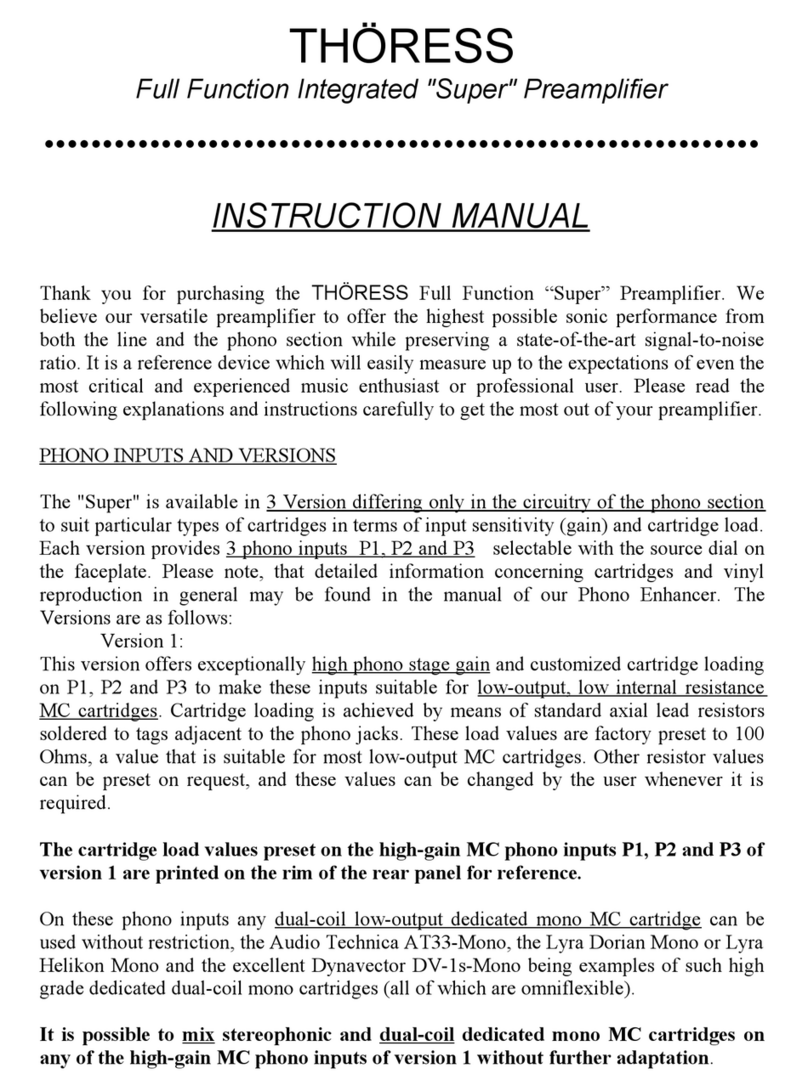
THÖRESS
THÖRESS Full Function Integrated "Super"... User manual

THÖRESS
THÖRESS 300B User manual

THÖRESS
THÖRESS SE300B User manual
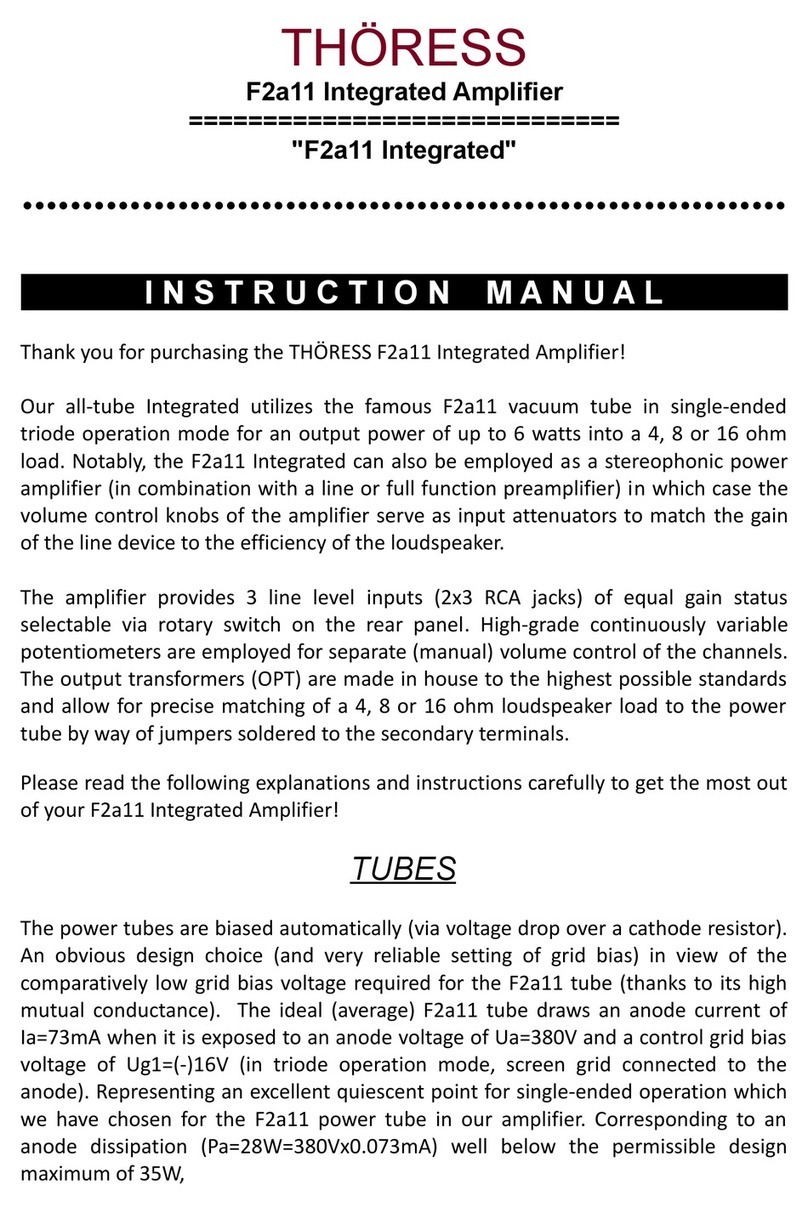
THÖRESS
THÖRESS F2a11 User manual
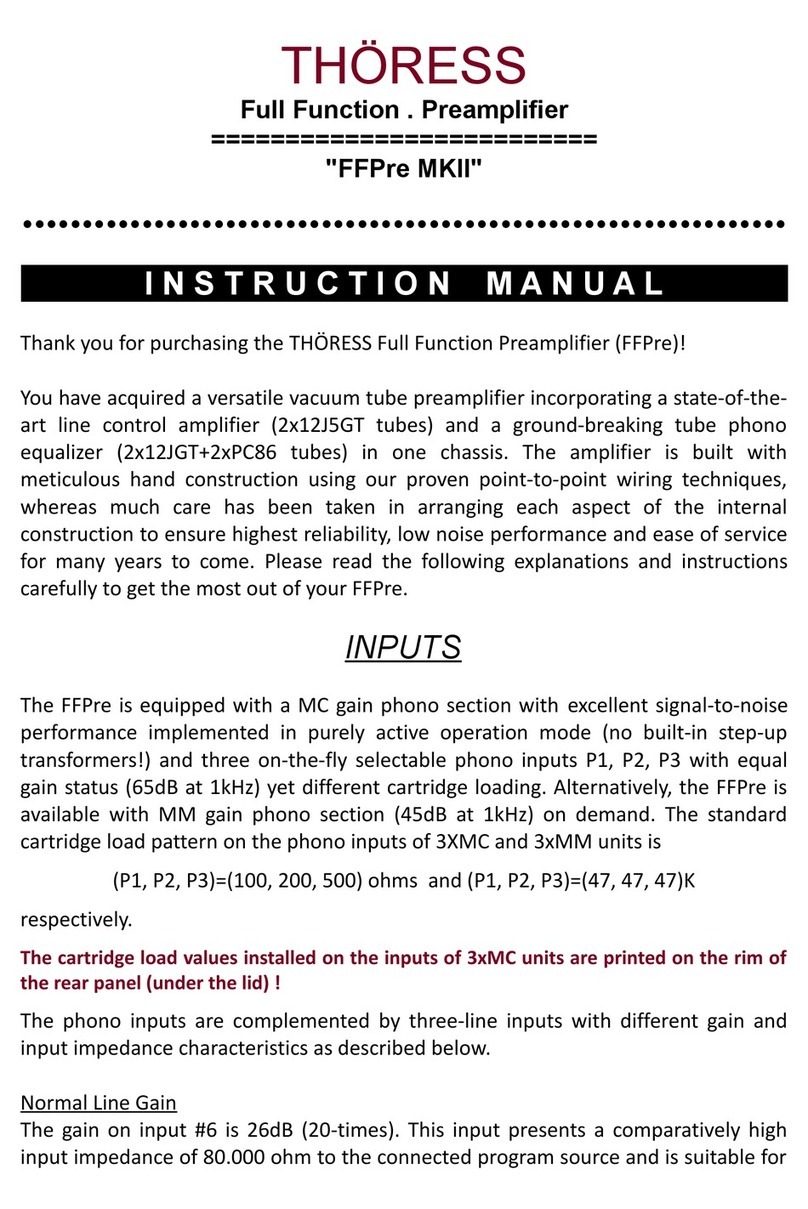
THÖRESS
THÖRESS FFPre MKII User manual
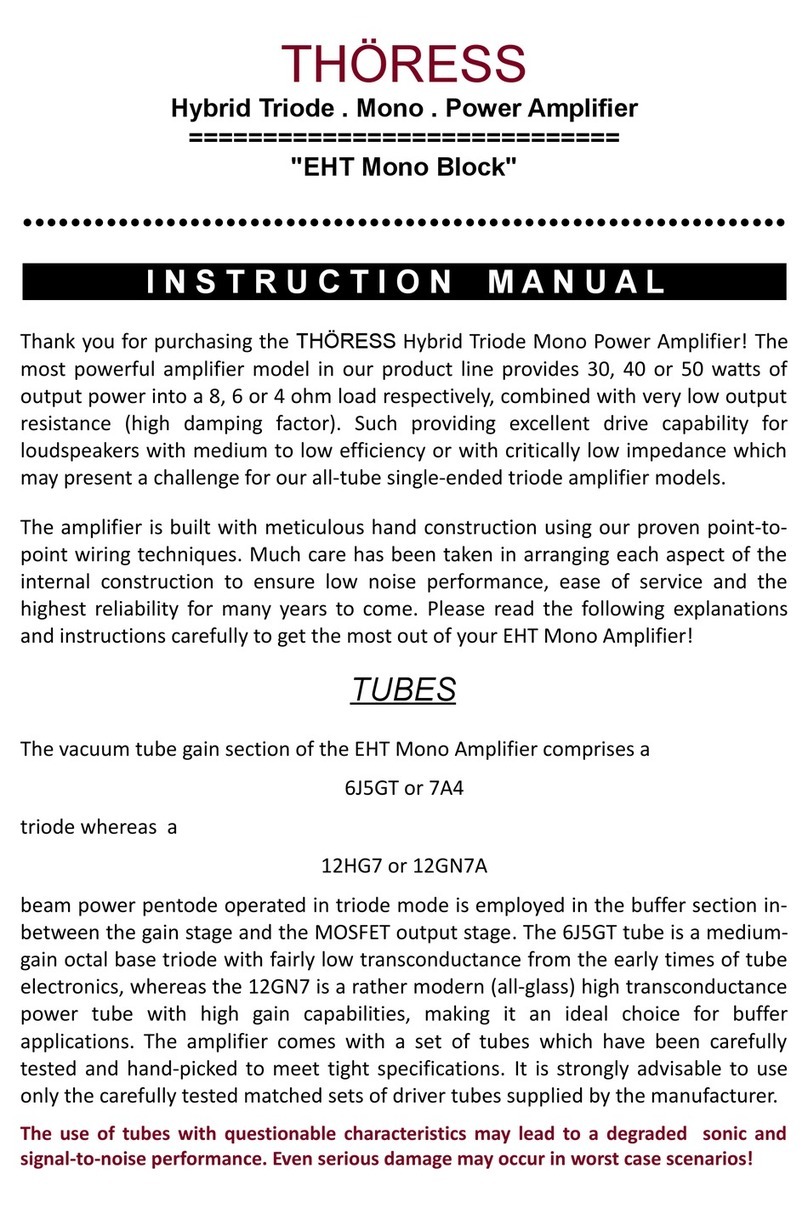
THÖRESS
THÖRESS EHT Mono Block User manual
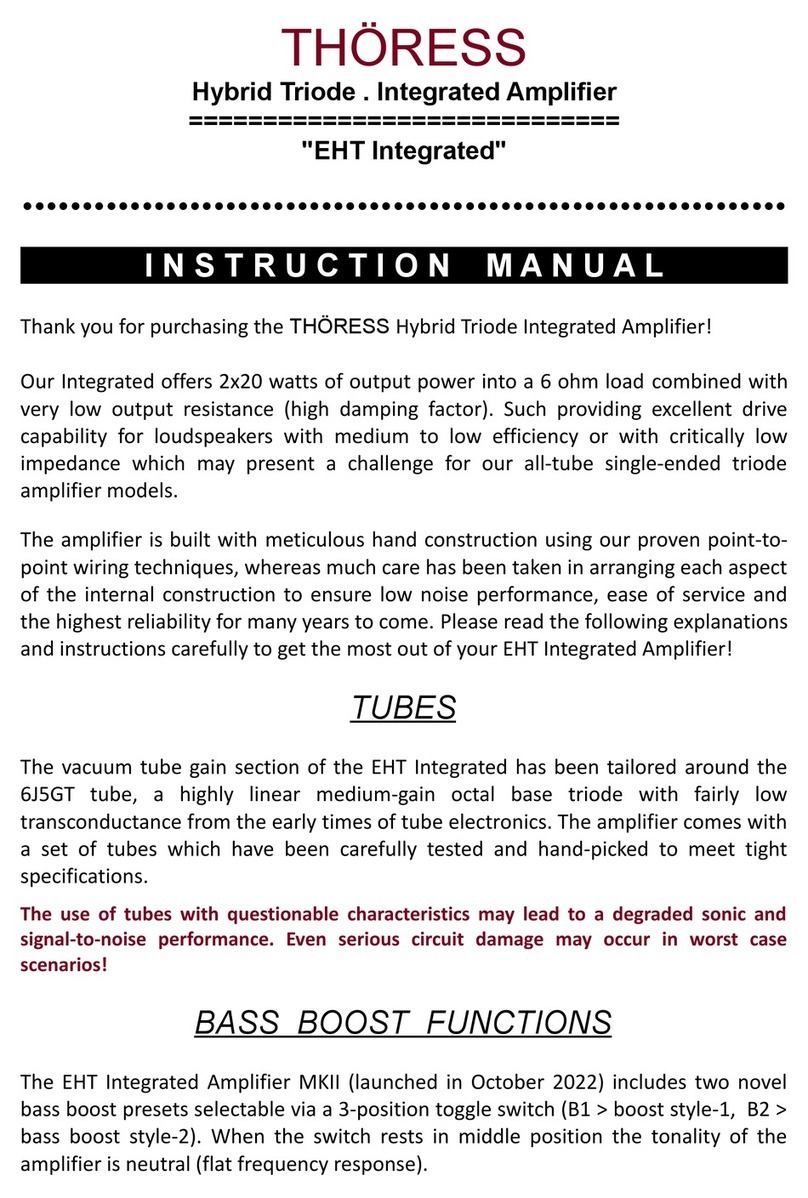
THÖRESS
THÖRESS EHT Integrated Amplifier MKII User manual
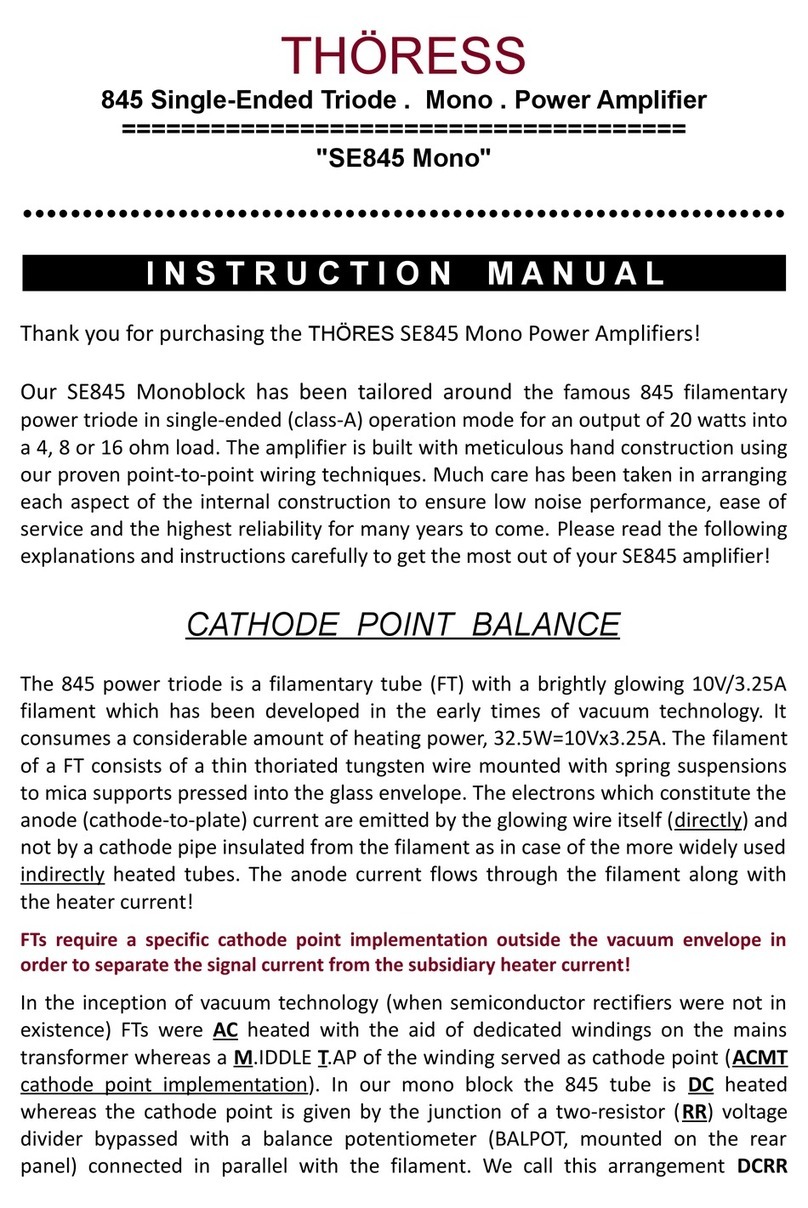
THÖRESS
THÖRESS SE845 Mono User manual
